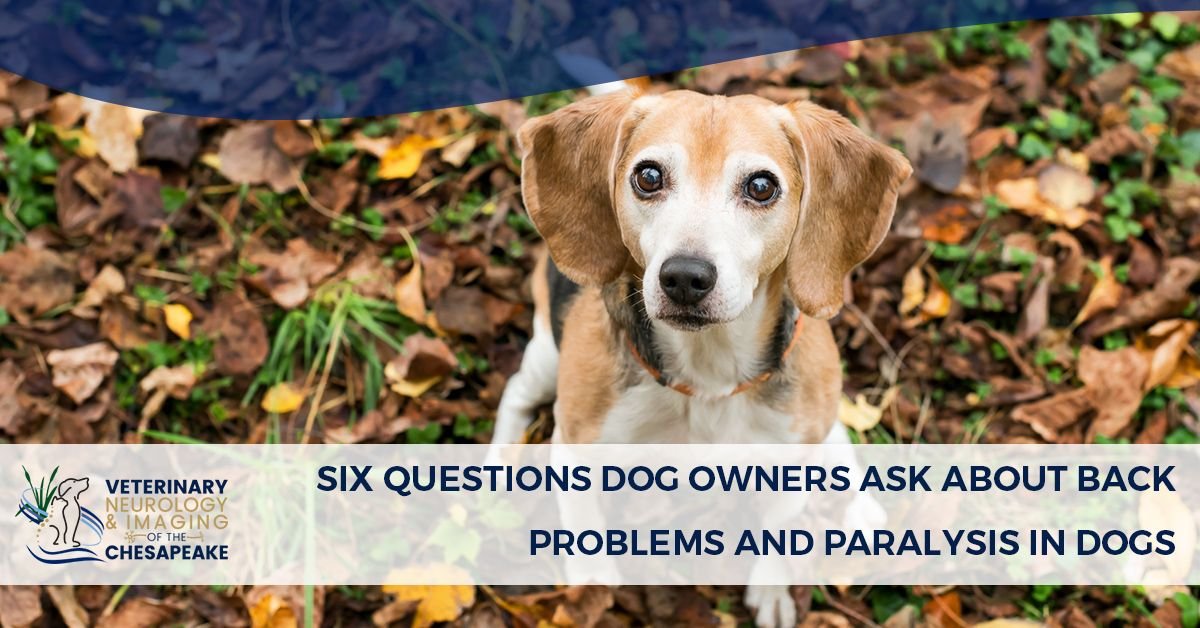SIX QUESTIONS DOG OWNERS ASK ABOUT BACK PROBLEMS AND PARALYSIS IN DOGS
Jay McDonnell, DVM, MS, Diplomate ACVIM (Neurology)
1. My dachshund is having trouble walking. My vet suspects that it’s a problem with his spine. Is there anything that can be done—or will my dog end up in a doggie wheelchair?
Dogs that can barely walk and those that can’t walk at all due to disk disease have an 80% to 95% chance to return to normal function with surgery.
First however, tumors, infections, strokes in the spine, and other conditions must be ruled out before a diagnosis of disk disease must be made. The gold standard for diagnosis of intervertebral disk disease (IVDD) is veterinary MRI.
After surgery, most dogs have a rapid recovery and can return to normal function in days to weeks. Medical treatment alone can provide improvement in 50-60% of cases, but 50% of those relapse within 6 to 10 months, typically with the problem in the same site. Those who have had surgery have little likelihood of relapse since surgery eliminates the problem.
Dogs that end up in carts either didn’t have the surgery, received medical treatment alone but are in the 40-50% that don’t respond to medical management, or are in the 5% that have a problem with the surgery.
2. What happens after the surgery?
After surgery, dogs are kept on crate rest for a specified time—generally four to six weeks—to allow for healing. During this time, the owner needs to be patient and committed to caring for the dog. Most care can be done three to four times a day, taking about 20 minutes each time.
3. Are there other treatments that can help?
Other treatments that can be of benefit the dog after surgery include physical therapy, nonsteroidal pain medication, acupuncture and canine rehabilitation. The latter has become a specialty unto itself, and can include underwater treadmill, swimming, laser therapy and ultrasound.
4. Are some dog breeds more prone to spinal problems?
IVDD occurs primarily in chondrodystrophic dog breeds (breeds with short legs and a long body); these include Dachshund, Bulldog, Corgi, Pug, French Bulldog, Basset Hound, Pekingese, Lhasa Apso, Shih Tzu, Beagle and Poodle.
5. What are the signs my dog might have IVDD?
Your dog may become quieter than normal, and reluctant to play or to jump on and off the furniture. You may think his stomach hurts, since pain is transferred from the back to the abdomen. He may wince or yelp when touched. Lameness or a change in gait, stiffness in the back, and lack of coordination can all be indications of a problem. As soon as you’re aware of the problem, see your veterinarian. Speedy diagnosis and treatment is critical.
6. Is there anything I can do to prevent my dog from getting IVDD?
Yes, there are two important things you can do. First, keep your dog from being overweight. Check a body condition scoring chart at your vet’s or online to see whether your dog is in the ideal range, too thin or too heavy; and talk with your vet about how to keep your dog at the ideal body size.
Second, prevent your dog from jumping. Too often dogs are allowed—or encouraged—to leap to or from the bed, couch, chair or into vehicles. Having your dog use stairs, a ramp, footstool or ottoman will help prevent strain and injury that can lead to IVDD.
Frank’s Story
This is Frank, he’s a 6-year-old Yorkie Mix. He is 6 years old and he came to VNIOC like this: completely paralyzed in his pelvic limbs; very painful; not able to urinate; and had gotten worse despite excellent medical treatment (crate rest, anti-inflammatories and pain medications).
Two hours after admission, he had a spinal MRI that found a large T12-13 disk that compressed his spinal cord by more than 45%. He had a hemilaminetomy that same day to remove the compression, inspect his spinal cord and fenestrate his disk space. He went home less than 4 days later able to move his legs, stand and urinate on his own.
Ten days after surgery, he is able to walk independently, is pain-free and expected to make a full recovery in another month.
This is the outcome in 95% of dogs like Frank that present to VNIOC for intervertebral disk disease.


